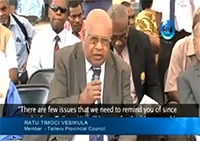The MIDA incident and the national Fiji discussion of “hate speech”, ethno-nationalism and the implied racism against Indo-Fijians, needs to be balanced by discussion of Indo-Fijian racism, which has been rarely discussed in public, yet is pertinent, writes Dr Wadan Narsey.
OPINION: Ashwin Raj, chairman of the Fiji Media Industry Development Authority (MIDA), has opened a veritable Pandora’s Box of questions with his reaction over the alleged “hate speech” by a Fijian leader, Ratu Timoci Vesikula, who was apparently giving advice to Rear-Admiral Voreqe Bainimarama on his campaign trail in his own province, Tailevu, last week.
Was Raj making his judgment from some English translation of Ratu Timoci's speech? If so, how accurate was the translation as there appear to be different versions circulating?
It is still not clear to the public what exactly were Ratu Timoci's words that could be reasonably construed to be “hate speech”, even after Raj’s explanations on the FBC TV programme 4 The Record.
How reasonable in law is it that the MIDA chairman can be prosecutor, judge and jury of third parties like Fiji Television (the “reporter” of the speech) even BEFORE the speaker and alleged culprit has been charged and found guilty of “hate speech” under current Fiji laws?
Could a mere 3 minute airing by Fiji TV of what Ratu Vesikula said be accurately called “unfettered coverage” as Raj claimed?
Could the fact that Bainimarama’s response to Ratu Timoci was not immediately aired by Fiji TV be reasonably called “unbalanced coverage” by Fiji TV, when most of Bainimarama’s speech at that Tailevu meeting was reported?
Could Fiji TV be accused of unbalanced media coverage over just this 3 minute news item, when it is abundantly clear that in any one week or month, Fiji TV gives probably 30times more coverage to Bainimarama, Khaiyum and other ministers than they do to the views of opposing politicians or traditional leaders like Ratu Timoci?
Media exposure
Is MIDA going to ensure that every time Bainimarama, Khaiyum or other government ministers get media exposure, that the media will be required to immediately give similar exposure to the opposition?
Is MIDA’s demand that all political speeches in the vernaculars be translated into English consistent with the human right of citizens, and politicians and voters, to communicate with each other in their own languages, without being forced to translate into English?
Is Ashwin Raj exhibiting some preconceived attitudes of his own when he defensively admonished the media:
“My decision this morning cannot be misconstrued as an impingement of freedom of expression or dismissed as yet another instance of gagging media freedom by MIDA as has been insinuated by some who are posturing as the praetorian guard of human rights but sadly very quiet over the issue of hate speech”. (My emphasis).
[Those who search for the meaning of “praetorian guard” may reach the interesting conclusion that for the last eight years in Fiji there has been only one set of praetorian guards, paid for by taxpayers, protecting a political emperor, for all of whom protecting human rights may be of little importance].
It would be wrong for critics to humorously brush off this MIDA incident as an example of yet another Don Quixote tilting at windmills in a Fiji which seems to provide a fertile ground for the unfettered (nice word, that) flexing of powers.
But there are three other important ongoing issues that this MIDA/Vesikula incident raises, which will continue to surface in the run-up to the September election and beyond, and need to be discussed by the public to put this MIDA incident in its proper perspective.
Indigenous concerns
1. Was Ratu Timoci legitimately raising indigenous Fijian concerns about indigenous Fijians systematically lagging behind in education and commerce, as allowed under the UN Declaration on the Rights of Indigenous Peoples, which concerns cannot be classified as “racism”.
2. It would seem that racism against Indo-Fijians was exercising the mind of the MIDA chairman when he quite extraneously compared Ratu Vesikula’s statement to that by Asenaca Caucau, a former SDL Minister, who had derogatively referred to Indo-Fijians as “weeds”. To balance this picture, we also need to acknowledge the racism by Indo-Fijians against indigenous Fijians.
3. We also need to acknowledge the pervasive internal racisms among Indo-Fijian groups such as Gujarati/Hindustani, North Indian/South Indian, upper caste/lower castes, Hindus/Muslims, fair-skinned/dark-skinned and religious bigotry for whom also, “race is a fact of life”, not dissimilar to Ratu Timoci’s view of Fijian and Indo-Fijian relations (however inaccurate).
If Fiji is to build a genuinely multi-racial society then we need to recognise Aall racisms, and not just target indigenous Fijians, as is the current vogue for a small coterie of powerful individuals in the Bainimarama regime.
Read Dr Wadan Narsey's full three-part article here
This work is licensed under a Creative Commons Attribution-NonCommercial 3.0 New Zealand Licence.





